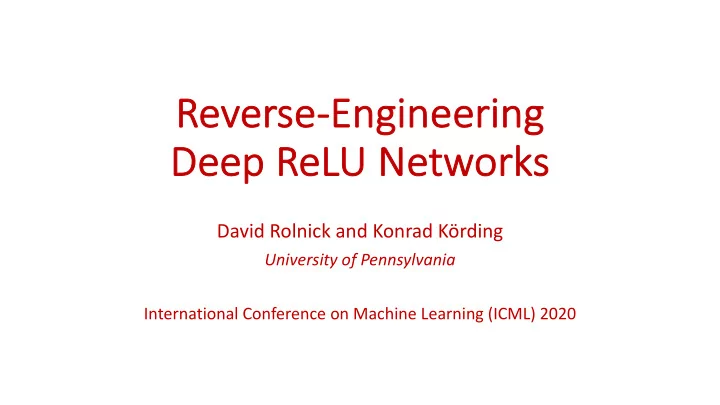

Re Reverse-Eng Engine neeri ring ng De Deep Re ReLU Ne Networ orks David Rolnick and Konrad Körding University of Pennsylvania International Conference on Machine Learning (ICML) 2020
Reverse-engineering a neural network Problem: Recover network architecture and weights from black-box access. Implications for: • Proprietary networks • Confidential training data • Adversarial attacks 1
Is perfect reverse-engineering possible? What if two networks define exactly the same function? ReLU networks unaffected by: • Permutation: re-labeling neurons/weights in any layer • Scaling: at any neuron, multiplying incoming weights & bias by , multiplying outgoing weights by Our goal: Reverse engineering deep ReLU networks up to permutation & scaling. 2
Related work • Recovering networks with one hidden layer (e.g. Goel & Klivans 2017, Milli et al. 2019, Jagielski et al. 2019, Ge et al. 2019) • Neuroscience, simple circuits in brain (Heggelund 1981) • No algorithm to recover even the first layer of a deep network 3
Linear regions in a ReLU network • Activation function: • Deep ReLU networks are piecewise linear functions: • Linear regions = pieces of on which is constant (Hanin & Rolnick 2019) 4
Boundaries of linear regions 5
Boundaries of linear regions Piecewise linear boundary component for each neuron (Hanin & Rolnick 2019) 6
Main theorem (informal) For a fully connected ReLU network of any depth, suppose that each boundary component is connected and that and intersect for each pair of adjacent neurons and . a) Given the set of linear region boundaries, it is possible to recover the complete structure and weights of the network, up to permutation and scaling, except for a measure-zero set of networks. b) It is possible to approximate the set of linear region boundaries and thus the architecture/weights by querying the network. 7
Main theorem (informal) For a fully connected ReLU network of any depth, suppose that each boundary component is connected and that and intersect for each pair of adjacent neurons and . a) Given the set of linear region boundaries, it is possible to recover the complete structure and weights of the network, up to permutation and scaling, except for a measure-zero set of networks. b) It is possible to approximate the set of linear region boundaries and thus the architecture/weights by querying the network. 8
Part (a), proof intuition Neuron in Layer 1 9
Part (a), proof intuition Neuron in Layer 2 10
Main theorem (informal) For a fully connected ReLU network of any depth, suppose that each boundary component is connected and that and intersect for each pair of adjacent neurons and . a) Given the set of linear region boundaries, it is possible to recover the complete structure and weights of the network, up to permutation and scaling, except for a measure-zero set of networks. b) It is possible to approximate the set of linear region boundaries and thus the architecture/weights by querying the network. 11
Part (b): reconstructing Layer 1 Goal : Approximate boundaries by querying network adaptively Approach: Identify points on the boundary by binary search using 1) Find boundary points along a line 2) Each belongs to some , identify the local hyperplane by regression 3) Test whether is a hyperplane 12
Part (b): reconstructing Layers ≥ 2 1) Start with unused boundary points identified in previous algorithm 2) Explore how bends as it intersects already identified 13
Why don’t we just… …train on the output of the black-box network to recover it? It doesn’t work. …repeat our algorithm for Layer 1 to learn Layer 2? Requires arbitrary inputs to Layer 2, but cannot invert Layer 1. 14
Assumptions of the algorithm Boundary components are connected Þ generally holds unless input dimension small Adjacent neurons have intersecting boundary components Þ failure can result from unavoidable ambiguities in network (beyond permutation and scaling) Note: Algorithm “degrades gracefully” • When assumptions don’t hold exactly, still recovers most of the network 15
More complex networks Convolutional layers • Algorithm still works • Doesn’t account for weight-sharing, so less efficient Skip connections • Algorithm works with modification • Need to consider intersections between more pairs of boundary components 16
Experimental results – Layer 1 algorithm 17
Experimental results – Layer ≥ 2 algorithm 18
Summary • Prove: Can recover architecture, weights, & biases of deep ReLU networks from linear region boundaries (under natural assumptions). • Implement: Algorithm for recovering full network from black-box access by approximating these boundaries. • Demonstrate: Success of our algorithm at reverse-engineering networks in practice. 19
Recommend
More recommend